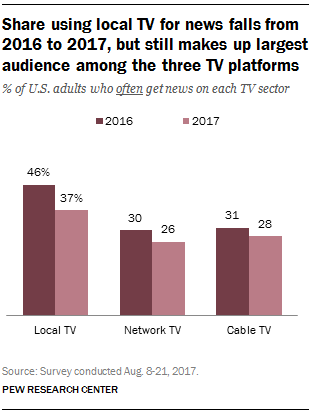Although fewer Americans rely on television for their news, television remains a substantial news source.
Half of U.S. adults obtain their news regularly from television, down from 57 percent in 2016, according to Pew Research Center. That’s still more than online news sources. Previous research found that 43% of Americans often get news online.

Image source: Vimeo
The research reveals much more: Preferences for local TV, network and cable news vary tremendously depending on viewers’ demographics.
Local TV has experienced the greatest decline but still garners a larger audience than cable or network, surprising as that may seem. The portion of Americans who often rely on local TV for their news fell from 46% to 37% from 2016 to 2017. Reliance on network TV news declined from 30% to 26%. Cable TV news viewing remained more stable, with 28% often getting news there last year, compared with 31% in 2016.
Insights into Demographics of TV News Viewers
Not surprisingly, adults in their 20s obtain their news from television less than seniors. Perhaps more surprisingly, college educated adults also view news on local and network TV less than those with no more than a high school degree. News use on cable varies little by education or income.
Nonwhites and women tend to view local TV news more than whites and men. In addition, Democrats tend to prefer network news; Republicans cable news.
The research provides public relations agencies and corporate departments demographic insights that can aid their PR campaigns. It also highlights the importance of including TV news in media relations and media monitoring.
Television placements can generate greater impact because the audience sees and hears the story. While print and online news readers typically skip many stories in an issue or website, it’s difficult for viewers to ignore the story when it’s on TV.
How to Obtain and Impress Clients
Broadcast media monitoring enables PR agencies to win new clients and impress current clients, experts say.
“Television is still the most influential medium, reaching millions of viewers every day,” states broadcast media search engine TVEyes in its Broadcast Monitoring for PR Agencies playbook. “With television exerting this much influence, can you afford to be without broadcast monitoring in your agency? Without it, you’ll miss new business opportunities and underserve your clients. Even worse, you may put them at risk of a crisis.”
It’s essential to follow best practices for winning broadcast media coverage and implementing TV news monitoring.
Monitor both local and cable TV channels and their websites. While many news organizations put some of their newscasts on their websites or on YouTube, not all stories from the live broadcast are posted and stories often are not posted in their entirety.
It’s best to integrate TV news monitoring into a comprehensive media monitoring service that includes online, print and social media. TV networks and local stations now promote their programs and engage with their audience on social media where viewers share and discuss TV news stories.
Bottom Line: Despite the rise of online news, TV remains the preferred source of news for many Americans. TV news is particularly popular among some demographic groups. That means it’s imperative to consider TV when developing PR campaigns and to include TV news in media monitoring.
William J. Comcowich founded and served as CEO of CyberAlert LLC, the predecessor of Glean.info. He is currently serving as Interim CEO and member of the Board of Directors. Glean.info provides customized media monitoring, media measurement and analytics solutions across all types of traditional and social media.





